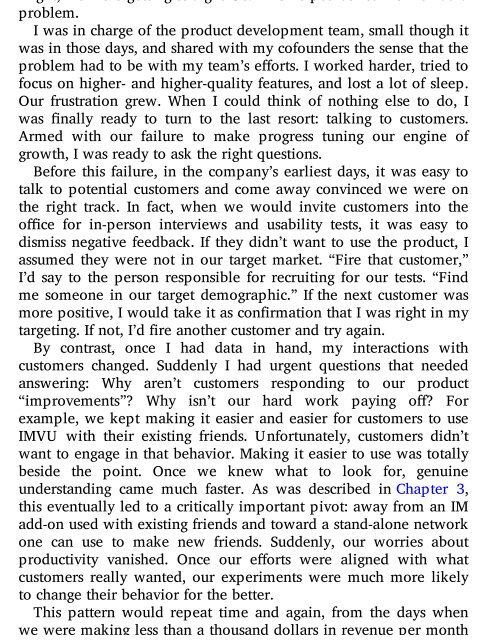Acclaim for THE LEAN STARTUP
The Lean Startup: How Today's Entrepreneurs Use Continuous ...
The Lean Startup: How Today's Entrepreneurs Use Continuous ...
- No tags were found...
Create successful ePaper yourself
Turn your PDF publications into a flip-book with our unique Google optimized e-Paper software.
might, we were getting straight C’s. This helped us realize we had a<br />
problem.<br />
I was in charge of the product development team, small though it<br />
was in those days, and shared with my cofounders the sense that the<br />
problem had to be with my team’s eorts. I worked harder, tried to<br />
focus on higher- and higher-quality features, and lost a lot of sleep.<br />
Our frustration grew. When I could think of nothing else to do, I<br />
was nally ready to turn to the last resort: talking to customers.<br />
Armed with our failure to make progress tuning our engine of<br />
growth, I was ready to ask the right questions.<br />
Be<strong>for</strong>e this failure, in the company’s earliest days, it was easy to<br />
talk to potential customers and come away convinced we were on<br />
the right track. In fact, when we would invite customers into the<br />
oce <strong>for</strong> in-person interviews and usability tests, it was easy to<br />
dismiss negative feedback. If they didn’t want to use the product, I<br />
assumed they were not in our target market. “Fire that customer,”<br />
I’d say to the person responsible <strong>for</strong> recruiting <strong>for</strong> our tests. “Find<br />
me someone in our target demographic.” If the next customer was<br />
more positive, I would take it as confirmation that I was right in my<br />
targeting. If not, I’d fire another customer and try again.<br />
By contrast, once I had data in hand, my interactions with<br />
customers changed. Suddenly I had urgent questions that needed<br />
answering: Why aren’t customers responding to our product<br />
“improvements”? Why isn’t our hard work paying o? For<br />
example, we kept making it easier and easier <strong>for</strong> customers to use<br />
IMVU with their existing friends. Un<strong>for</strong>tunately, customers didn’t<br />
want to engage in that behavior. Making it easier to use was totally<br />
beside the point. Once we knew what to look <strong>for</strong>, genuine<br />
understanding came much faster. As was described in Chapter 3,<br />
this eventually led to a critically important pivot: away from an IM<br />
add-on used with existing friends and toward a stand-alone network<br />
one can use to make new friends. Suddenly, our worries about<br />
productivity vanished. Once our eorts were aligned with what<br />
customers really wanted, our experiments were much more likely<br />
to change their behavior <strong>for</strong> the better.<br />
This pattern would repeat time and again, from the days when<br />
we were making less than a thousand dollars in revenue per month




